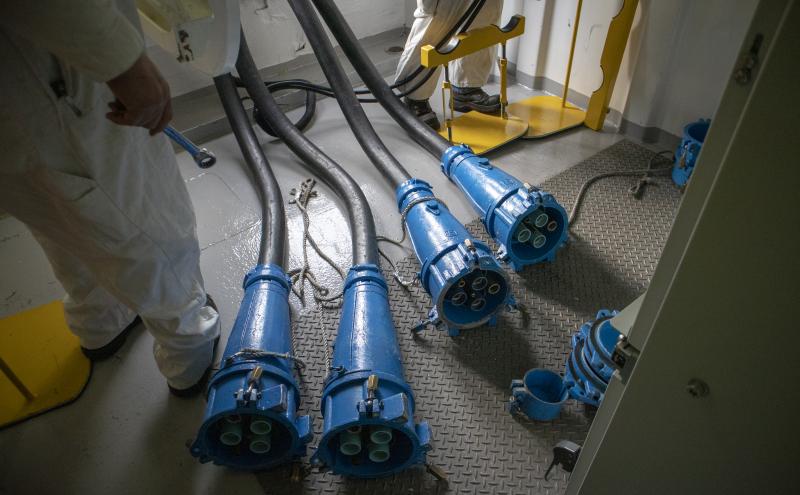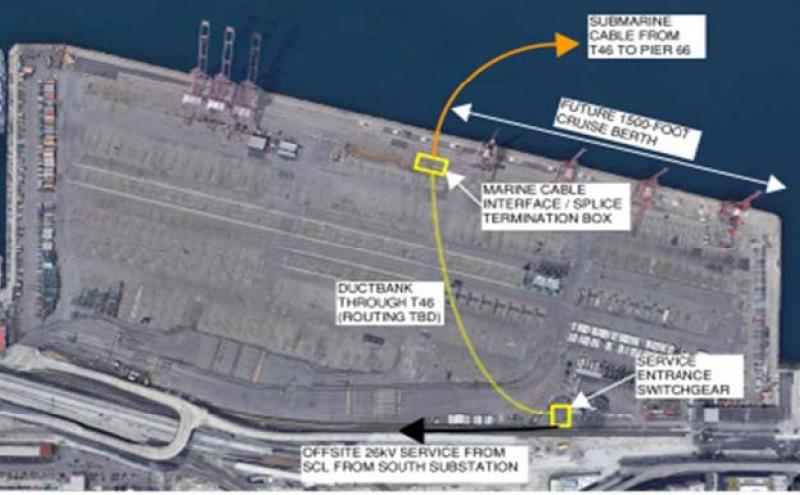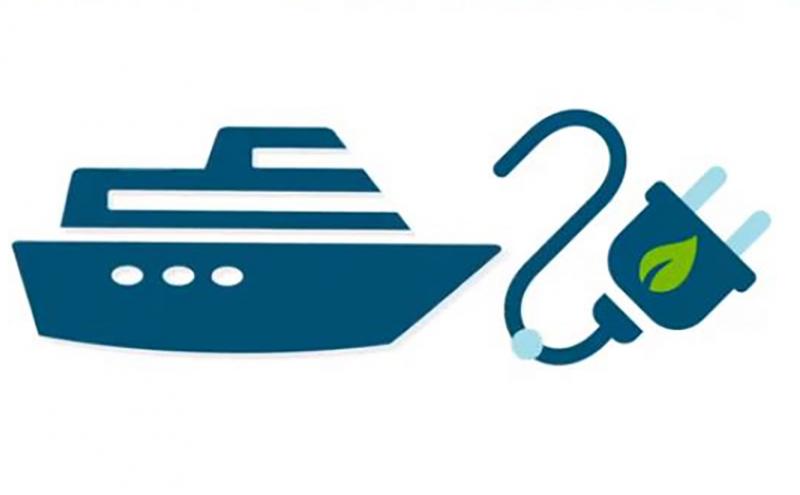By Cathy Swift (Port) and Julie Moore (Seattle City Light)
On December 14, 2021 the Port of Seattle Commission authorized spending $7.6 million to bring clean electrical power to ships berthed at Pier 66. The Commission authorized the Port to purchase a proprietary shore power system and begin working with Seattle City Light to supply shore power to cruise ships berthed at Pier 66.
“Electrification of the waterfront is a key step the Port can take toward advancing the decarbonization of the maritime industry,” said Port of Seattle Commission President and The Northwest Seaport Alliance Co-Chair Fred Felleman. “Installation of shore power at Pier 66 will mean that all equipped cruise ships calling on Elliott Bay will be able to turn off their engines while at berth. This will not only reduce greenhouse gas emissions and air pollution impacting neighboring communities, but it will further demonstrate our commitment to being the greenest cruise ship homeport in North America which is good for the environment and the economy."
Delivering electrical shore power to Pier 66 is an early action in the Port’s long-term waterfront clean energy strategy. The project is also one early example of how a new partnership with Seattle City Light helps the Port unwind particularly tricky infrastructure and technology conditions.
The provision of shore power for cruise ships is the Port’s greatest opportunity to reduce greenhouse gas (GHG) emissions and improve local air quality.
Currently, the Port’s Smith Cove Cruise Terminal at Terminal 91, which began operations in 2009, provides shore power at its two cruise vessel berths. The single berth facility at Pier 66’s Bell Street Pier Cruise Terminal, which opened in 1999, does not have shore power for cruise vessels. To enable future shore power connections by shore power capable cruise ships that call on Pier 66, the Port has been working closely with Seattle City Light (City Light), Northwest Seaport Alliance, City of Seattle, and other partners to plan and provide shore power to the Bell Street Pier Cruise Terminal.
Shore power at Pier 66 will be accomplished through an innovative approach: installing a submarine cable from Terminal 46 to Pier 66 in lieu of bringing power through the congested City right-of-way. This approach significantly reduces project costs and avoids construction-related impacts to the waterfront.
The Port of Seattle has a mission to become the greenest port in North America and to phase out all seaport-related emissions by 2050. It’s not a new goal, and pilot projects that inform a larger and more robust strategy have been collecting data for more than a decade.
Collaborating for clean energy
With the launch of the Seattle Waterfront Clean Energy Strategy, the Port of Seattle, the Northwest Seaport Alliance (NWSA), and Seattle City Light are on a mission to bring clean energy to the waterfront and the maritime community. That larger and more robust strategy has arrived
"Growing cargo volumes that bring family-wage jobs to our region doesn’t have to come at the cost of our environment,” stated Port of Tacoma Commission President and The Northwest Seaport Alliance Co-Chair Dick Marzano. “The Northwest Seaport Alliance is glad to partner with Seattle City Light to ensure our strategic investments are backed by clean energy and support our surrounding environments and job opportunities for years to come.”
This newly-minted collaborative agreement will bring a refreshed, ambitious, and holistic strategy; a long term (10 years) and structured partnership; and collaboration between all partners to set common goals, communicate, and build a clean energy infrastructure.
“A lot of our strategy will include electrification of heavy duty transportation and industrial facilities. So the Port, the Northwest Seaport Alliance, and Seattle City Light are working together to make sure that the clean power infrastructure is ready to use when and where the Port and its tenants need it,” said David Fujimoto, Senior Environmental Program Manager for the Port’s Maritime and Environmental Sustainability team.
Port of Seattle
The use of clean energy at Port facilities is not a new idea — the Port has installed solar panels at several waterfront facilities, uses renewable natural gas to heat the airport, advocates for wind power and the successful Clean Fuels Standard, uses renewable diesel in the Port’s vehicle fleet, and launched a pilot program for clean shore power in the cruise industry.
The Northwest Seaport Alliance
Strategic investments in clean energy operations is becoming a competitive advantage in the transpacific trade as the container vessel fleet serving the Pacific Rim is becoming increasingly shore power capable. Shore power on international container terminals has been a focus of The Northwest Seaport Alliance (NWSA) investments with installation at Husky Terminal in Tacoma and Terminal 5 in Seattle with plans for future installation at Terminal 18. The NWSA will also be welcoming the first zero-emission cargo handling equipment to our gateway, taking the opportunity to prove the efficiency of clean energy technologies in port operations.
Seattle City Light
Seattle City Light is committed to using clean power to help improve air quality and lessen greenhouse gas emissions. About 94 percent of the power generated by City Light comes from clean and carbon-free resources. The remainder is purchased on the energy market and the utility pays credits to offset emissions so that the utility’s entire electricity portfolio is carbon neutral.
Multiple public and private maritime entities along the Seattle Waterfront have committed to combatting climate change through 2050 and City Light is positioned to be a major player in the solution by delivering electrification.
“Seattle City Light is excited to follow through on a commitment we made with the Port over two years ago to jointly create a clean energy future that will benefit our customers, the region, and its residents,” said Debra Smith, City Light General Manager and CEO. “The benefits of this effort extend beyond the maritime sector to help address environmental burdens that have been borne by historically disadvantaged communities along the Waterfront and Duwamish River watershed.”
City Light is putting significant effort into not just serving existing customers with carbon-neutral electricity but also enabling customers to reduce or eliminate GHG emissions via several pathways. While capacity, technology, economic, and regulatory hurdles prevent immediate transition to clean electricity for all end users, reduction of emissions can start now through energy efficiency, optimizing operations, lower-carbon and sustainable fuels, shifting timing of loads, energy storage, and many other solutions. This is where collaboration with the Port and NWSA really delivers. While there are many possible approaches to reduce GHG emissions, concerted and collaborative efforts from the Port, NWSA, and City Light will develop the best solutions as part of an overall strategy.









